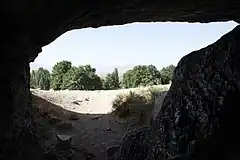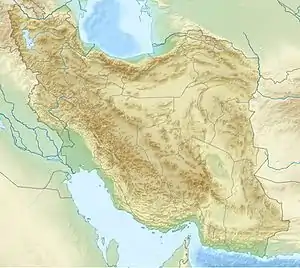 excavations in 1949 | |
 location in Iran | |
| Location | Kermanshah province |
|---|---|
| Region | Iran |
| Coordinates | 34°23′26″N 47°26′13″E / 34.39056°N 47.43694°E |
| History | |
| Periods | Middle Paleolithic |
| Cultures | Mousterian |
Bisitun Cave (also called "Hunter's cave", Bisotun [Farsi], Bisetoun [Kurdish], Bisitoun, or Behistoun) is an archaeological site of prehistoric human habitation in the Zagros Mountains in the Kermanshah province, north-west Iran. Bisitun Cave is one of five caves situated at the base of The Rock of Bisitun, a 1,300 m (4,300 ft) high cliff within the Chamchamal Plain.[1] It was first excavated in 1949 by Carlton Coon, and is notable for the discovery of Mousterian stone tools of the Middle Paleolithic, as well as the remains of 109 identifiable species of Pleistocene mammals, and hominid remains.[2][1] Harold Dibble described the stone tools as having strong Levallois components. All artefacts are apparently from the same period.
It has not been possible to discern a geological age of the Middle Paleolithic levels at Bisitun Cave. However, the relative abundance of Cervus in the deposits suggests a nearby woodland, and such vegetation is indicative of a warmer later Pleistocene phase. In Southwestern Asia in general, the Middle Paleolithic falls between the Later Middle Pleistocene (Marine Isotope Stage 6/7) and the middle of the Last Glacial (mid Marine Isotope Stage-3). Therefore the age of Bisitun Cave is likely to fall within this period also.[1]
Hominin remains
Coon described two hominid remains from the site, a maxilliary upper incisor and a radius shaft fragment, both from a layer designated F+. These remains were listed but never described fully for the palaeontological community. When they were finally re-examined four decades later, the incisor was found to be bovid in origin, rather than hominin.[1] The radius fragment was found to show Neanderthal affinities, as it is mediolaterally expanded at the interosseus crest.[3] The radius fragment also showed signs of scavenging carnivores or rodents, such as jackal and fox, the remains of which were also found at the site.
See also
References
- 1 2 3 4 Trinkaus, E; Biglari, F (2006). "Middle Paleolithic Human Remains from Bisitun Cave, Iran". Paléorient. 32 (2): 105–11. doi:10.3406/paleo.2006.5192. Retrieved December 1, 2012.
- ↑ Dibble, HL (1984). "The Mousterian Industry from Bisitun Cave (Iran)" (PDF). Paléorient. 10 (2): 23–34. doi:10.3406/paleo.1984.937. Archived from the original (PDF) on March 5, 2012. Retrieved December 1, 2012.
- ↑ Trinkaus, Erik; Biglari, F. (2006). "Middle Paleolithic Human Remains from Bisitun Cave, Iran". Paléorient. 32 (2): 109. doi:10.3406/paleo.2006.5192. ISSN 0153-9345.
Further reading
- Coon, C.S. 1951. Cave exploration in Iran 1949 (Museum Monographs). Philadelphia (PA): University Museum, University of Pennsylvania Press